“Süleyman’s Place”
Of all Sinan’s great designs for Constantinople the one that is usually thought of as his masterpiece is the Süleymaniye complex that bestrides the Third Hill and dominates the skyline from the Golden Horn. It is far and away the main reason to come to this part of the old city although the surrounding streets are also full of picturesque wooden houses that are gradually being restored as well as many lovely old fountains.
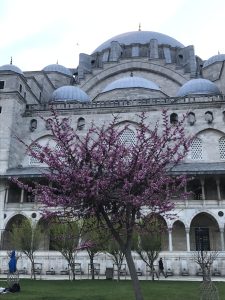 Süleymaniye Cami
Süleymaniye Cami
After many years of restoration the Süleymaniye Cami finally reopened to the public in 2011 and it is now possible to appreciate the true magnificence of Sinan’s work, the huge dome soaring up over what seems like the never-ending marble space of the interior.
The mosque was designed to celebrate the thirtieth anniversary of Süleyman the Magnificent‘s accession to the throne between 1550 and 1557. When he died in 1566 the sultan was buried in the mosque grounds as was his famous Ukrainian wife, Roxelana. With its multiple domes and four minarets it exemplifies the perfection of early Ottoman architecture although Sinan himself is said to have regarded the Selimiye he designed for Edirne as his masterpiece.
Not surprisingly, the interior of the mosque was worked on by the finest craftsmen of their day, including a glazier called Sarhoş İbrahim (İbrahim the Drunkard) and a calligrapher called Ahmed Karahisarı who is thought to have gone blind as a result of a lifetime of writing so that his work had to be finished off by his apprentice, Hasan Çelebi. The walls of the mosque are papered with İznik tiles from the finest period of production. Materials to beautify the mosque were also brought from all over the Empire. One of the columns supporting the dome is believed to have come from the Temple of Artemis at Ephesus, two from sites outside the city walls and the fourth from Egypt.
Many claims are made about the symbolism embedded in the mosque although whether they are true is open to question. For example, the four minarets are said to symbolise the fact that Süleyman was the fourth sultan to be based in Constantinople while the 10 şerifes (minaret balconies) are said to mark his status as the tenth Ottoman sultan. Even the four columns supporting the dome are said to symbolise the four caliphs. Make of this what you will.
But what makes the Süleymaniye so particularly special is that much of the külliye (complex) of buildings offering social facilities that was attached to it still survives intact.
The former imaret once produced food for several thousand people daily. The courtyard in front of it is shaded by a plane tree said to date back to the 15th century. Take a stroll round its porticoes (if you can) and you’ll come across a marble ice-box weighing 7,000 kilograms. Right next door was the kervansaray where travellers and their pack animals could be accommodated overnight. It’s not currently accessible. Nor is the huge Dar-üs şifa (hospital) building, which was also restored in 2009.
Of most interest are the many medreses built on three sides of the mosque which laid the foundation for what was to become İstanbul University. To one side are the Salis and Rabi medreses, on the other are the matching Eyvvel and Sani medreses, each of them designed to teach one of the schools of Islamic law. The Eyvvel and Sani medreses now house the Süleymaniye Kütüphanesi, a splendid library which has become the repository for books collected from many other Ottoman libraries around town.
Heading back downhill towards Kapalı Çarşı (the Grand Bazaar) you will pass the much less obvious building that houses the Dar-ül hadis Medresesi but which now plays host to a long line of small shops. Most medreses are designed with the student cells opening off a central courtyard and the dershane (lecture theatre) in the centre of one of the sides. Here, however, 22 such cells formed a straight line, with an open-air platform above them serving as the dershane.
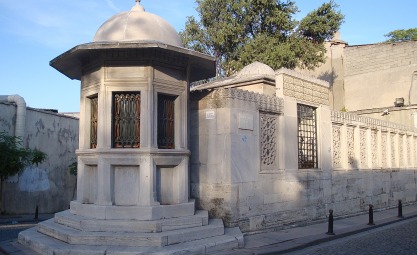 Sinan’s tombNear it is the Süleymaniye Hamam (Turkish bath) which is still in business today. It’s one of the most beautiful in the city which makes it a great shame that it was designed with only one bathing chamber so that it now offers mixed bathing, something that won’t suit all visitors.
Sinan’s tombNear it is the Süleymaniye Hamam (Turkish bath) which is still in business today. It’s one of the most beautiful in the city which makes it a great shame that it was designed with only one bathing chamber so that it now offers mixed bathing, something that won’t suit all visitors.
One final medrese, the Mülazim, was actually a preparatory school built on platforms cut into the hillside beneath the Salis and Rabi medreses.
The single oddest component of the complex was the Tiryaki Çarşısı (Addicts’ Market) where it appears that opium was sold to go with the tea and coffee.
Around the Süleymaniye
The great architect Sinan lived near the mosque for many years and is buried within sight of it in the pretty open-sided tomb he designed for himself inside a walled garden with an attractive sebil (water dispensary) on the corner.
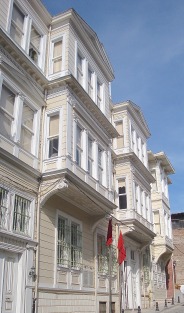 As is often the case in Turkey an area – in this case Süleymaniye – that was once very desirable fell on very hard times in the early 20th century, with many of the lovely old wooden houses slowly falling apart for lack of money to repair them. That situation is slowly being reversed under the auspices of KUDEB, a government agency tasked with restoring old buildings and finding new uses for them. It is housed in one of the finest mansions in the area, the Kayserili Ahmed Paşa Konağı (Kayserili Ahmed Pasa Sokağı), dating back to the second half of the 19th century. If you can get inside you will be able to admire its magnificent painted ceilings and panelled walls.
As is often the case in Turkey an area – in this case Süleymaniye – that was once very desirable fell on very hard times in the early 20th century, with many of the lovely old wooden houses slowly falling apart for lack of money to repair them. That situation is slowly being reversed under the auspices of KUDEB, a government agency tasked with restoring old buildings and finding new uses for them. It is housed in one of the finest mansions in the area, the Kayserili Ahmed Paşa Konağı (Kayserili Ahmed Pasa Sokağı), dating back to the second half of the 19th century. If you can get inside you will be able to admire its magnificent painted ceilings and panelled walls.  Restoration work in progress in the Kayserii Ahmed Paşa Konağı
Restoration work in progress in the Kayserii Ahmed Paşa Konağı
Eating
For some extraordinary reason the area around the Süleymaniye Cami is known for restaurants serving cheap and tasty kuru fasuliye, the Turkish take on baked beans. The Tarihi Süleymaniye Kurufasulyeci (tel: 0212-513 6219) has been in the business for best part of a century. Come here at iftar during Ramazan and you will be astonished at how many bowls of beans can be dished up in minutes.
Transport info
There are two main ways to approach the Süleymaniye, both involving a bit of walking.
The first is to head north from behind the Kapalı Çarşı (Covered Bazaar) along ÇadırcIlar Caddesi which becomes Fuatpaşa Caddesi. If you then turn left along Sami Onar Caddesi you will come out close to the Dar-ül hadis and the Süleymaniye Hamam.
Alternatively you can make your way from Beyazıt to the Kalenderhane Cami, walk through the Aqueduct of Valens and turn right which will bring you out close to the other side of the mosque.
The nearest Metro station is at Vezneciler which is close to the Kelenderhane Cami.
Nearby areas
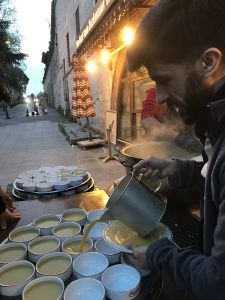
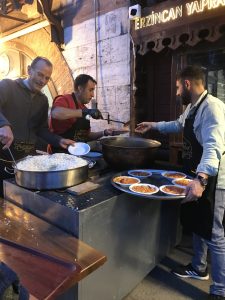
Preparing for iftar in front of the Süleymaniye Cami

